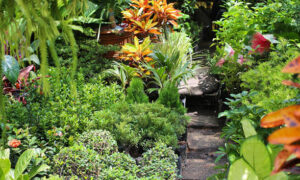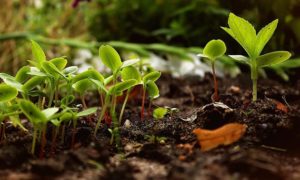Imagine you only need to wake up in the morning on a sunny day and take a handful of herbs, a tomato when it is ripe, and a bunch of fresh greens all from your backyard.
The entire concept of turning your garden into a food farm is not to grow food, but to create a small living ecosystem that will provide you with not just your food, but also provide for your soul. You do not need acres of land, or fancy tools; you only need a little space, patience, and curiosity.
Here in this guide, are the steps by which you will transform your garden into an edible paradise. And your garden will not only be pretty in the end, it will nourish you too.
Overview of the Process
The following is a list of simplified steps to follow:
- Observe & plan
- Build soil
- Design layers & choose plants
- Prepare zones/beds
- Plant thoughtfully
- Maintain and adapt
We’ll discuss each one of them.
Step 1: Observe & Plan Your Food Farm
a. Walk and Observe
Spend part of your time in your garden. Notice:
- When and where does the sun or shade occur?
- How the water flows.
- How the wind moves.
- Plants that already grow well; what kind of plants are there.
- What pests or animals may be present?
Another one, also consider wild areas or surrounding forests (where possible). What is the natural vegetation? Good hints as to what will thrive in your garden.
b. Site Survey & Map
Make a simple sketch or map. Mark:
- The walls, horizon, slope and fences.
- Sun direction (morning sun, afternoon shade)
- Water (low areas, hose, rain barrel)
- Plants, bushes or trees present.
This map will help you in knowing where the big trees, small shrubs, herbs, and vegetables will be located.

c. Set Your Goals
Ask yourself:
- Would I like food for my family or food to sell?
- Do I tend to be more interested in mostly perennial (trees, shrubs) or annual (vegetables) plants?
- What is the duration of time I’m going to spend on maintenance?
- Do I want to expand over time?
Well defined goals will enable you to make improved design choices.
Step 2: Build Good Soil
Good soil is the foundation by which you expect your plants to thrive.
a) Add Organic Matter & Compost
Add compost, leaf mold, decomposing manure – compounds high in carbon and nitrogen to mix into your topsoil. The soil microbes break them down and provide nourishment to plants with time.
The use of green manure (fast-growing coverage crops) to fix nitrogen and to loosen the soil is the other method of fixing nitrogen and loosening the soil.

b) Use Mulch and Sheet Mulch (Lasagna Gardening).
The ground should be covered with mulch (straw, leaves, wood chips) to control weeds and retain the moisture, in addition to feeding the soil over time. One is sheet mulching (called lasagna gardening) whereby cardboard or newspaper is placed, then organic matter, then the mulch. Months are needed to kill the weeds, and the layers break down to form fertile soil.
c) Test and Balance Soil (where possible)
Test your soil when you have the time, with regards to the pH and the nutrient content; then put in soil amendments (lime, rock phosphate, wood ash, etc.), where required. The soil also needs to be well drained – this avoids prolonged puddles.

Step 3: Design Layers & Choose Plants
One of the exciting ideas in food farming is layering, in which plants are planted in vertical layers such that the plants are sitting so that you can use the area in an appropriate manner. A food forest normally has many layers.
Here are common layers:
- Canopy/overstory trees (fruits or nut trees)
- Understory / dwarf trees
- Shrubs (berries, bushes)
- Herbs/ vegetables (herbaceous).
- Groundcover/soil cover plants.
- Vines / climbers
- Root crops/bulbs
In selecting plants, select the plants that:
- Fit your climate.
- Share water and nutrient requirements.
- Are mutually supporting (company planting / guild structure).
- Add nitrogen-fixers, active accumulators, and repel pests.
An example would be the plant legumes (beans, peas) to help the neighboring fixation of nitrogen. Moreover, group plants which have similar watering demands.
All the layers do not need to be planted at once; a few trees and shrubs and herbs – and leave the system to grow.
Step 4: Prepare Zones or Beds
Divide your garden into zones or beds based on how you plan to use them. For example:
- High-care (near the house) areas of vegetables, herbs.
- Medium-care areas of bushes, fruits.
- Low-care areas (even further) of trees.
It may be raised beds, hügelkultur mounds (wood + soil), keyhole gardens, or standard garden beds. Among them is one such special technique which is the keyhole garden: a raised circular garden with a path cut through it such that one can easily reach the center. The center usually has compost materials which nourish the soil around it. This is a good design which is effective when there is a lack of space.

With flooded lands, there is also the floating garden, which consists of making floating beds of compost and plants over the water. This may work for your own local circumstance.
Starting out with a manageable bed or zone to gain experience, you can then grow from there.
Step 5: Planting Thoughtfully & Building Your Food Farm
- Space between plants: Do not overcrowd, also good circulation of air between plants can help to prevent disease, and may help prevent stunted plants. Practice succession planting by replanting after harvesting in the same area.
- Group planting: Use functional group planting together. Combine symbiotic groupings of mutual aiding plants, e.g. one fruit tree with a band of nitrogen producers rounding off its base is the very height of natural stability).
- Water wisely: Water new plants using a soaker hose or drip hose, and collect water in barrels.
- Mulch thickly: When the plant is laid in place, mulch it with leaves or leafy compost around the bottom which will serve to moisten the soil, keep off the weeds, and keep the soil in its place.
In time your garden will be self-sustaining.

Step 6: Maintaining & Adapting Your Food Farm
- Walk in your garden often (after every few days) to familiarize yourself with the behavior of various elements. Some will need your attention, while others will require a different approach.
- Manage and control the expansion. Prune large plants to ensure that every layer of the plant gets sunshine, and that air circulation is maintained.
- Feed your soil. Use and apply compost, mulch, and organic manure. Healthier plants will result from living soils.
- Expand in phases, which is a constructive approach. Enjoy the process and let one section finish completely before starting the next. You will reap the rewards.
- Promote different plant species. Various types will control pests, and bring the ecosystem to better balance.
In patience and regularity your garden will come to nurture herself – a breathing, living, growing, and regenerating mechanism.

Tips & Warnings (Things to Watch Out For)
- Start small. If you try to change everything at once, everything might crash.
- Be patient. You cannot fast-track a food forest or a food farm.
- Beware of shade. Small plants can be shadowed by large trees that are wrongly planted.
- Pests and weeds will be annoying you. But they are not insurmountable problems, not with good mulch, diversity, and monitoring.
- Don’t over-fertilize. Excess nutrients in natural systems are harmful.
- Work with your climate. Pick plants that will be suitable for your seasons (cold, heat, and rain).
- Learn as you go. There are a lot of local books, online resources, and gardeners to help.
Why a Food Farm Works & What You Gain
- Edible gardens and food forests are nature-based — high biodiversity, collaboration, nutrient cycling.
- Over time as you add trees and perennials your system becomes more self-sustaining.
- Labor can be reduced when the system is established.
- You do not harvest just one crop in your garden; you have fruits, veggies and herbs.
- It turns the area into a living ecosystem, and there are beneficial insects, soil organisms, birds etc.

Final Thoughts & Next Steps
Making your garden a food farm does not only imply getting into the garden to plant but it is a method of going back to the essence of life. Every seed that you plant recalls you of patience, care, and renewal.
In the long term, your garden is going to be not just a means of food but also going to represent your hard work, passion, and love.
Begin small, remain inquisitive, and follow nature. You will find that, the same day you tasted something that was grown by your own hands, you will know, this is what it feels like to be really abundant. Also do check out our post on permaculture – it’s a very similar concept.





